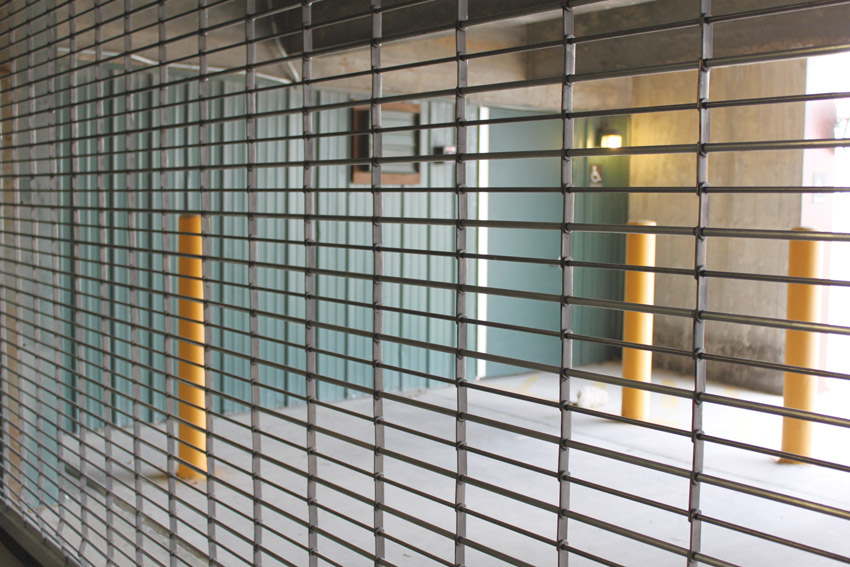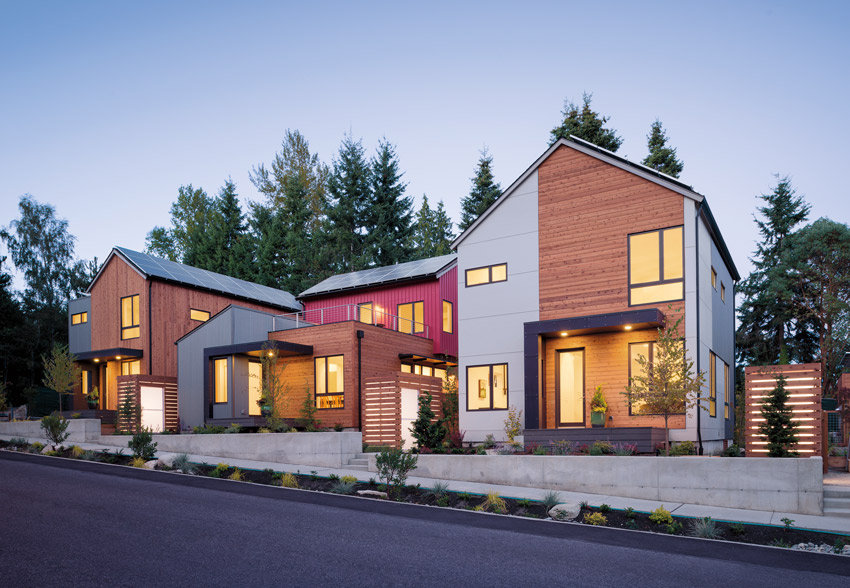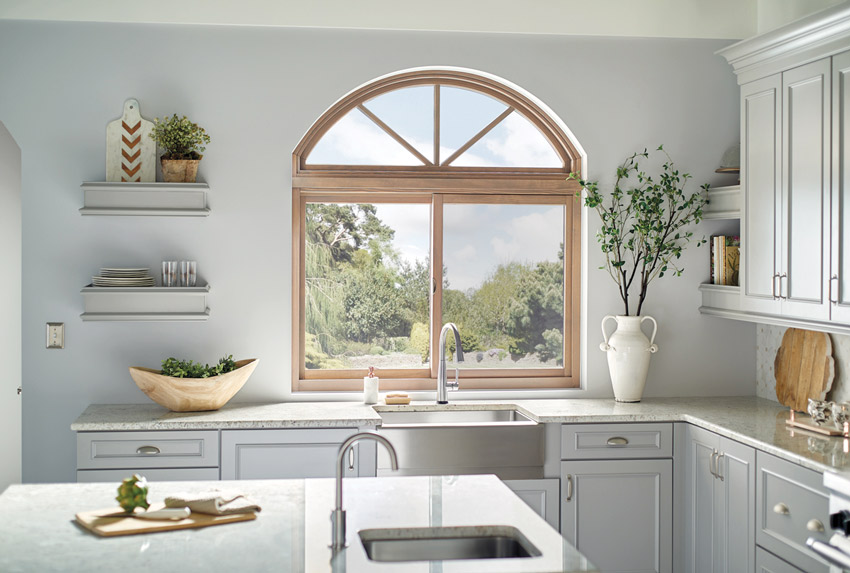Advances in Fenestration Design and Functionality
High-Performance Grilles and When to Use Them
High-performance grilles can provide a number of advantages for such applications as parking garages, storage facilities, and a host of other building types. Benefits include aesthetics, security, and visibility. High-performance grilles not only provide valuable functionality but also give the feeling of openness. They are available in myriad colors to suit the style of virtually any building.
According to Siva Davuluri, director of strategic marketing at CornellCookson, for parking garages in particular, grilles are the most common option, even compared to doors. He says, “Architects, owners, and designers like the open feeling as opposed to having a dark, closed space. With many parking garages, the same grille panels are used to make fixed panels around the perimeter so it all looks similar with the same cohesive design. For security purposes, high-performance grilles help security personnel to see there is no one doing mischief. Also, high-performance grilles aid with visibility for customers, making it easier for cars to see what’s behind the opening.”

Photo courtesy of CornellCookson
The benefits of high-performance grilles include aesthetics, security, and visibility.
Cycle Counts and Why They Matter
The term cycle means one full opening and closing of a door or grille—going from fully closed, fully open, and back again. The Door & Access Systems Manufacturers Association (DASMA) definition of high-performance doors states that they must meet the 100 cycles per day mark, except that cycles of doors/grilles aren’t always spread out over the entire day. There is a significant difference in wear (and subsequently in construction requirements) for a grille that will cycle 100 times in one hour vs. one that will cycle four times each hour for 24 hours.
Figuring out the right kind of cycle life (meaning maximum cycles expected during peak periods, not just total cycles) is critical to selecting the right type of high-performance door.
Total cycles matter, but as noted, timing matters more. Let’s say you have a grille in a parking garage with 100 spots in a secure building that requires proof of clearance to enter and closes after each car passes through. There is only one way to enter, and staff that work in the building have shift times that start between 7 a.m. and 9 a.m. and end between 3 p.m. and 5 p.m. This means you’ll have 200 daily cycles, but the vast majority will be in two separate two-hour windows. Your door must be able to handle the high use in the short window of time without breaking down or wearing out.
High-Performance Construction vs. High-Cycle Springs
A true high-performance rolling grille must be built for durability from the bottom up. There is a myth circulating in the industry that springs = cycle life. If everything about your high-performance grille is the same as a standard grille, but you put high-cycle springs on it, you have a high-cycle-spring grille—not a high-performance grille. In fact, the gold standard for high-performance rolling closures is actually a springless design. Springs inevitably break and need to be replaced, causing downtime and maintenance fees.
So, what else needs to be built for high performance? The operator system, for one, needs to be able to handle the maximum number of cycles in the minimum amount of time you expect to use it. A direct drive operator is a good investment, as there are no chains or sprockets to wear out. And it should feature a soft start and stop to increase life by reducing wear and tear. On open, the speed of a best-in-class, high-performance rollup grille should start opening at a slow speed, ramp up in the middle, and then slow down before reaching the fully open position. The reason is to reduce wear and tear on all door components, but especially the operator. The guides (metal channels that hold the curtain in) also need to be robust enough to handle frequent fast operation. Experts recommend looking for self-lubricating guides to prolong curtain life.
Choosing Materials for Design and Functionality
The fenestration materials that you choose matter to the design, function, and longevity of your building—whether it’s withstanding weather or replicating the details of historic design. Choosing the right material for windows and doors is an important but sometimes confusing decision—the core structural composition, interior material, and exterior cladding all contribute to appearance and performance.
It is recommended to look for a manufacturer where experts regularly assess each material and adjust selection, testing, and design accordingly in an effort to make durable and high-performing products.
Among the most popular window and door materials in the marketplace—each offering unique benefits and advantages for homeowners, builders, and architects—are the following:
- Wood is a premium material for windows and doors, offering classic aesthetic appeal, many options for customization, and design versatility, creating a warm, natural feeling within contemporary spaces and historic buildings alike. Also, it handles various treatments and finishes well. Unlike other materials, wood has an inherent richness due to it being a natural material—no two pieces are exactly alike.
As a material, wood offers many benefits. It maintains its properties throughout drastic temperature changes. It also provides exceptional insulation. And it is a renewable material that also requires very little energy in the production of an end product, making wood an environmentally friendly option.
According to Ben Wallace, materials science manager at Marvin Windows and Doors, one caveat with wood is that if wood has too much moisture, it is more vulnerable to warping and unable to accept preservatives, paints, or stains. He recommends making sure the manufacturer confirms that suppliers are consistently grading lumber and providing the moisture content required. He adds, “To be sure that the wood has the right percentage of moisture content, the manufacturer should take an extra step once they receive it from suppliers, running cut lumber through machines that measure its moisture content. If the moisture content does not fall within the acceptable 6 to 12 percent range, the machine should separate the unsatisfactory lumber from the rest of the wood. This attention to wood throughout the supply chain contributes to quality craftsmanship, as well as longevity and performance of products over time.”

Photo courtesy of Marvin Windows and Doors
Wood is among the most popular window and door materials in the marketplace, offering environmental benefits, excellent insulation, and classic aesthetics, as well as many options for customization and design versatility.
- Extruded aluminum is an extremely tough cladding that protects wood windows. This results in superior durability for the major clad components of typical fenestration products —frame, sash, casing, and divided lites.
Thin aluminum, however, can dent easily, causing headaches for homeowners and builders alike. To provide protection and strength, experts recommend looking for extruded aluminum that exceeds industry standards, thereby elevating exterior cladding to a new level of performance.
Some manufacturers’ extruded aluminum meets the highest American Architectural Manufacturers Association (AAMA) 2605 standard, which requires 10 years of color retention and chalk resistance. An extruded aluminum substrate with an extremely tough surface coating will result in significantly superior surfaces on major clad components.
Unlike rollform aluminum, high-quality extruded aluminum profiles are formed first, then painted, which results in superior adhesion and a consistently uniform finish. The AAMA 2605 standard for rollform aluminum components requires only a 0.9-millimeter finish thickness, instead of the 25 percent thicker 1.2-millimeter coating required to meet the AAMA 2605 standard for extruded aluminum. This means that the extra finish provides increased protection, thickness, and durability, ensuring that clad products meeting these specifications will retain their color, gloss, and beauty for years to come.
- Pultruded fiberglass, an innovative material that is highly durable, as strong as steel, extremely reliable, and can perform as well years after installation as it does on day one—requiring little maintenance.
Composite materials used by different manufacturers will vary. Experts recommend thermoset composite materials rather than thermoplastic. When the material makeup contains a high density of woven fibers bound by a thermally set resin, it will make the product more resistant to pressure and temperature than thermoplastic composites. Thermosets, in fact, will hold their shape up to 285 degrees Fahrenheit. This means that windows using this type of composite will maintain their shape—even in harsh climates with regular exposure to temperature variation.
Notice

www.cornelliron.com/300Grille

www.crl-arch.com

tiny.cc/GrahamSR6700

www.GuardianJumboGlass.com

www.marvin.com

www.milgard.com/windows/essence-series/

www.nanawall.com

www.vetrotechusa.com

www.vitrocsaUSA.com











